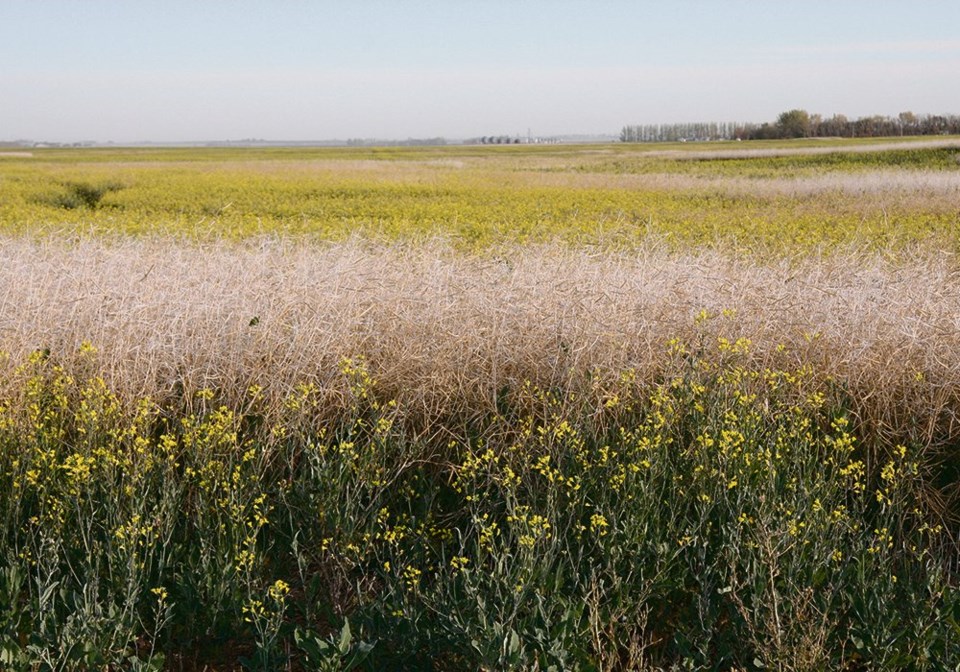Many parched fields of harvested canola have been flooded with yellow blooming flowers from sprouting canola.
“In a lot of cases where the rain came, the volunteer second growth did look better than the original crop,” said Shawn Senko, agronomy specialist for the Canola Council of Canada in Saskatoon, who is also a cattle producer near Humboldt, Sask.
While it’s common to see small patches of regrowth following most harvests, this year’s drought in July and precipitation in September created good growing conditions for volunteer canola.
“I don’t think I’ve ever seen it quite to this extent. We’ve had dry years, but you need the dry year plus that recharge in the fall to really kick it back into gear and grow. So there’s pretty much the perfect storm for it,” he said.
Clint Jurke, also an agronomist for the canola council, said it’s the first time he’s seen such widespread regrowth.
“It really comes down to the fact that the crop didn’t utilize the fertility that was available in the soil. Once the moisture did come at harvest, the crop decided now’s a great time to start regrowing.
“There’s a lot of crop nutrients and soil nutrients that weren’t utilized this year. And that’s why the crop is responding to it.”
In a normal growing season, canola will come to maturity and shut down after being harvested. Any lost seed could germinate and produce volunteers. This year, however, well-established canola roots sent up new shoots because it never finished its growing cycle due to the drought.
Senko said a lot of areas in fields were so drought stressed that they didn’t mature and produce a proper seed set.
“It was still in vegetative state when it was cut.”
Many farmers terminated a lot of volunteer canola during post-harvest weed spraying. Freezing nights are now killing off the rest left standing.
However, some regrowth was so large that several livestock producers are taking advantage by cutting and baling the volunteer crop or making silage.
“The entire last month there was fields of canola going down and being cut for green feed for cattle. And it’s still being baled up at this point right now,” Senko said.
At his own farm, Senko produced 50 bales from a 100-acre canola field, which he plans to feed to his cattle this winter.
“If it wasn’t a greenfield crop, I wouldn’t be really happy with that but with today’s hay prices it was a good payback. Used some nutrients for next year and some moisture but really there’s no inputs into it other than the cutting and baling. So I think anybody who cut and baled it got a cheap feed source,” he said.
While it’s good feed source, Senko said producers must watch for certain things, such as nitrates.
“Test and make sure when you’re feeding it. It may need to be mixed in with something else, so be cautious of that.”
Harvested cereals like barley and oats are also seeing a spike in regrowth.
“Pretty much anything that was cut for green feed originally is regrowing now because of the same thing — they never really finished,” said Senko.
Instead of baling, some farmers are using portable electric fencing and turning their cattle into fields, allowing the cattle to graze the regrowth.
Jurke advised farmers to complete soil tests next spring to determine how much nutrition is available and the amount of fertilizer needed.
“The tough thing of all of this is if they should be booking fertilizer now given the prices, or if it should be done in the spring. That’s a tough one,” he said.
Senko said producers should also monitor the amount of snow cover and temperature this winter.
“If you get that heavy snowfall without really cold temperatures, it kind of makes an insulating blanket and then those plants could still be here next year growing fast.
“So probably just the way that the weather is going it’s good news for controlling the volunteer canola,” he said.
Added Jurke: “It’s not going to be a crop that they’ll need to be concerned about next spring. The caveat to that is if these plants are really big and boisterous it might cause some residue issues. Then there might be something that farmers will have to do.”

